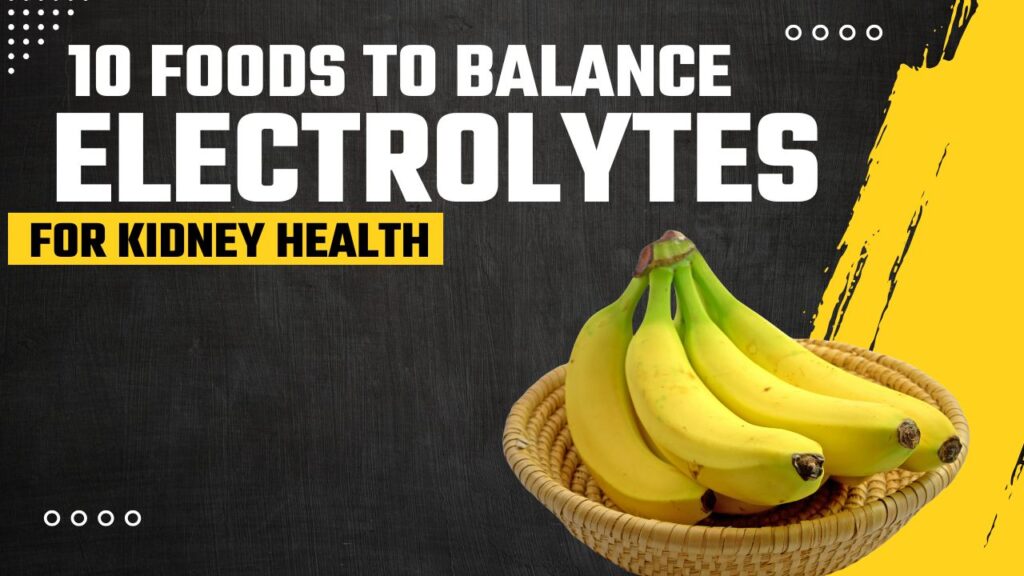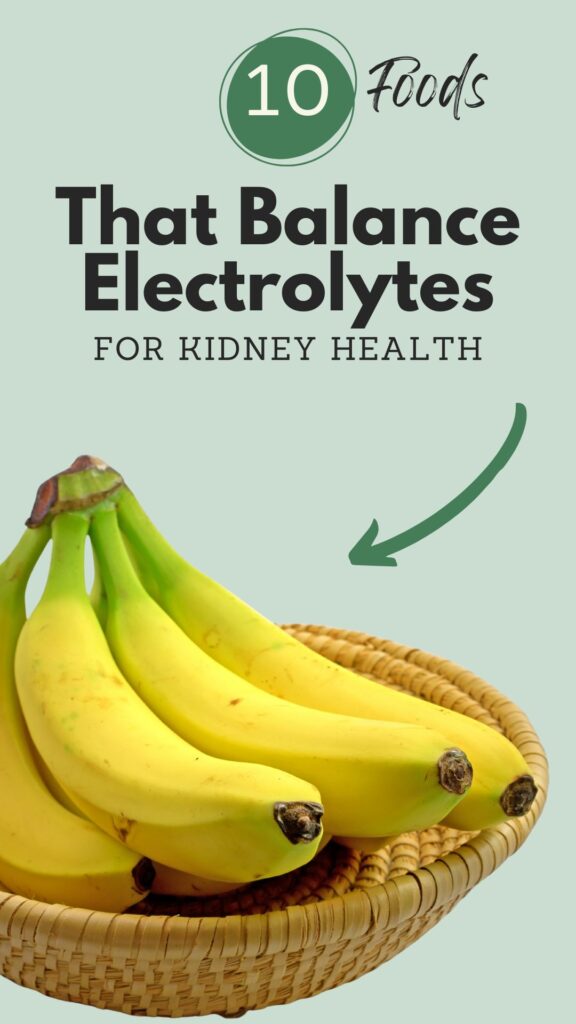Did you know that something as simple as dehydration or poor diet can throw your electrolytes off balance and put extra strain on your kidneys?
Electrolytes—like sodium, potassium, calcium, and magnesium—are not just “salts” in your body. They are the spark plugs that keep your muscles moving, your nerves firing, and your kidneys filtering waste efficiently.
When these levels drop or rise too high, you may feel fatigue, muscle cramps, brain fog, or even face serious kidney problems.
This post will guide you through 10 natural, nutrient-packed foods that can help balance electrolytes while supporting kidney health. Along the way, you’ll discover:
- Which everyday foods restore essential minerals naturally.
- The best ways to eat them for maximum benefit.
- Who should include them in their diet—and who might need to be cautious.
- Storage, buying tips, and possible side effects you may not know.
If you’ve ever wondered, “What can I eat to keep my electrolytes balanced without relying on sports drinks?” —this article has you covered.

Table of Contents

10 Best Foods For Kidney Health
1. Coconut Water
Often called “nature’s sports drink,” coconut water is naturally rich in potassium, magnesium, sodium, and calcium. These minerals make it one of the best hydrators for both kidney and electrolyte health.
Best Ways to Eat or Use It
- Drink chilled as a refreshing beverage.
- Add to smoothies for a hydrating base.
- Use in soups or curries instead of broth for a mineral boost.
Who Should Eat / Avoid
- Good for: athletes, people in hot climates, those with mild dehydration.
- Avoid/Limit if: you have kidney disease and need to limit potassium intake.
Storage & Buying Tips
- Choose fresh green coconuts when possible.
- Store packaged coconut water in the fridge once opened.
- Avoid brands with added sugar.
Do’s & Don’ts
| ✅ Do | ❌ Don’t |
|---|---|
| Drink fresh after workouts | Rely on it as your only fluid |
| Buy unsweetened versions | Drink if you need low potassium |
Possible Side Effects
Excessive intake may raise potassium levels too high in people with impaired kidney function.
2. Bananas
Bananas are one of the most well-known potassium-rich foods, which helps regulate muscle contractions and kidney filtering.
Best Ways to Eat or Use It
- Eat raw as a snack.
- Blend into smoothies.
- Mash into oatmeal or spread on whole-grain toast.
Who Should Eat / Avoid
- Good for: athletes, people with low potassium, those needing quick energy.
- Avoid/Limit if: you have advanced kidney disease or are on potassium-restricted diets.
Storage & Buying Tips
- Buy slightly green if you want them to last longer.
- Store at room temperature; refrigerate to slow ripening.
Do’s & Don’ts
| ✅ Do | ❌ Don’t |
|---|---|
| Pair with protein like nut butter | Overeat if on a low-potassium diet |
| Use ripe bananas for smoothies | Store near apples (ripens too fast) |
Possible Side Effects
Too many bananas can lead to hyperkalemia (high potassium), especially in kidney patients.
3. Spinach
Spinach contains potassium, magnesium, and calcium, all crucial for maintaining electrolyte balance and kidney support.
Best Ways to Eat or Use It
- Lightly sauté with garlic.
- Add to salads, wraps, or smoothies.
- Steam instead of boiling to preserve minerals.
Who Should Eat / Avoid
- Good for: those needing extra magnesium and calcium.
- Avoid/Limit if: you have kidney stones (high oxalate content).
Storage & Buying Tips
- Buy fresh, crisp leaves.
- Store in the fridge with a damp paper towel.
Do’s & Don’ts
| ✅ Do | ❌ Don’t |
|---|---|
| Eat fresh in salads | Overcook (loses nutrients) |
| Pair with citrus for better absorption | Store in airtight without airflow |
Possible Side Effects
High oxalates may increase kidney stone risk in sensitive individuals.
4. Sweet Potatoes
Rich in potassium and magnesium, sweet potatoes help regulate blood pressure and electrolyte levels.
Best Ways to Eat or Use It
- Bake, roast, or mash.
- Add to soups or grain bowls.
Who Should Eat / Avoid
- Good for: those with high blood pressure, athletes.
- Avoid/Limit if: you need a strict low-potassium diet.
Storage & Buying Tips
- Store in a cool, dry place (not fridge).
- Choose firm, blemish-free roots.
Do’s & Don’ts
| ✅ Do | ❌ Don’t |
|---|---|
| Bake for best flavor | Refrigerate raw sweet potatoes |
| Combine with healthy fats for absorption | Fry in unhealthy oils |
Possible Side Effects
Too much potassium from overconsumption may strain kidneys in people with kidney disease.
5. Yogurt
A powerhouse of calcium, sodium, and magnesium, yogurt also promotes gut health which indirectly supports kidney function.
Best Ways to Eat or Use It
- Enjoy plain or with fruits.
- Add to smoothies or overnight oats.
- Use as a base for dips.
Who Should Eat / Avoid
- Good for: people with lactose tolerance, athletes, women needing calcium.
- Avoid/Limit if: lactose intolerant or sensitive to dairy.
Storage & Buying Tips
- Keep refrigerated at all times.
- Choose unsweetened Greek yogurt for more protein.
Do’s & Don’ts
| ✅ Do | ❌ Don’t |
|---|---|
| Buy plain, unsweetened | Eat flavored with added sugar often |
| Pair with fruits/nuts | Leave unrefrigerated |
Possible Side Effects
Dairy sensitivity may cause bloating or digestive discomfort.
6. Watermelon
Made of 90% water, watermelon helps hydrate while providing potassium and magnesium.
Best Ways to Eat or Use It
- Eat fresh slices.
- Blend into juices or smoothies.
- Freeze into popsicles.
Who Should Eat / Avoid
- Good for: dehydration, summer refreshment.
- Avoid/Limit if: diabetic patients should watch portion sizes (natural sugars).
Storage & Buying Tips
- Choose firm, symmetrical melons.
- Store whole at room temp; refrigerate after cutting.
Do’s & Don’ts
| ✅ Do | ❌ Don’t |
|---|---|
| Eat chilled in hot weather | Eat too much if diabetic |
| Store cut pieces in fridge | Leave cut melon outside |
Possible Side Effects
Overeating may cause bloating due to high water content.
7. Avocados
Avocados are rich in potassium, magnesium, and healthy fats, making them excellent for kidney support.
Best Ways to Eat or Use It
- Mash into guacamole.
- Slice over salads and toast.
- Blend into smoothies.
Who Should Eat / Avoid
- Good for: heart health, athletes, people on plant-based diets.
- Avoid/Limit if: you are on a strict low-potassium diet.
Storage & Buying Tips
- Buy slightly firm; ripen at room temperature.
- Store cut avocado with lemon juice in an airtight container.
Do’s & Don’ts
| ✅ Do | ❌ Don’t |
|---|---|
| Eat with whole-grain toast | Overconsume if kidney issues |
| Use lemon to prevent browning | Store uncut in fridge too early |
Possible Side Effects
High potassium may be risky for those with advanced kidney disease.
8. Oranges
Packed with potassium, calcium, and magnesium, oranges are hydrating and kidney-friendly in moderation.
Best Ways to Eat or Use It
- Eat whole as a snack.
- Squeeze fresh juice.
- Add zest to dishes.
Who Should Eat / Avoid
- Good for: immune health, hydration, athletes.
- Avoid/Limit if: you have acid reflux (citrus may worsen it).
Storage & Buying Tips
- Pick firm, heavy oranges.
- Store in a cool place or refrigerate.
Do’s & Don’ts
| ✅ Do | ❌ Don’t |
|---|---|
| Eat whole for fiber | Rely only on juice |
| Store in fridge for longer life | Leave in hot places |
Possible Side Effects
Too much juice may cause acid reflux or excess sugar intake.
9. Almonds
Almonds are rich in magnesium and calcium, vital for electrolyte and kidney balance.
Best Ways to Eat or Use It
- Eat raw or roasted.
- Add to trail mix, smoothies, or salads.
- Use almond butter as a spread.
Who Should Eat / Avoid
- Good for: weight management, bone health.
- Avoid/Limit if: nut allergies or chronic kidney disease requiring phosphate restriction.
Storage & Buying Tips
- Store in airtight jars.
- Keep in cool, dry place or refrigerate for longer freshness.
Do’s & Don’ts
| ✅ Do | ❌ Don’t |
|---|---|
| Eat soaked almonds | Overeat (calorie-dense) |
| Pair with fruits | Store in humid areas |
Possible Side Effects
Overeating can cause digestive discomfort and high calorie intake.
10. Tomatoes
Tomatoes are rich in potassium and also provide antioxidants like lycopene, which support kidney and heart health.
Best Ways to Eat or Use It
- Eat raw in salads.
- Make soups, sauces, or salsas.
- Pair with olive oil for better lycopene absorption.
Who Should Eat / Avoid
- Good for: people with low potassium needs, general kidney health.
- Avoid/Limit if: you have acid reflux or advanced kidney disease.
Storage & Buying Tips
- Buy firm, red tomatoes.
- Store at room temperature (not fridge) for best flavor.
Do’s & Don’ts
| ✅ Do | ❌ Don’t |
|---|---|
| Cook with olive oil | Refrigerate unripe tomatoes |
| Eat fresh for hydration | Consume too much if reflux |
Possible Side Effects
Acidity may cause reflux symptoms in sensitive individuals.
Conclusion
Balancing electrolytes is not just about drinking sports drinks—it’s about choosing the right foods that naturally support your kidneys.
From coconut water to spinach and almonds, each of these foods adds a unique blend of minerals to keep your body in balance.
Whether you’re an athlete, someone recovering from dehydration, or simply looking to support long-term kidney health, adding these foods into your daily meals can make a noticeable difference.
Try experimenting with one or two of these foods in your next recipe. Your kidneys—and your energy levels—will thank you.
What’s your go-to food for staying hydrated and energized? Share your favorite recipe in the comments!
Frequently Asked Questions (FAQs)
What are electrolytes and why are they important for kidney health?
Electrolytes are minerals like sodium, potassium, calcium, and magnesium that regulate fluid balance, nerve signals, and muscle contractions. Healthy electrolyte levels prevent kidney strain and support proper filtration of waste.
Can I balance electrolytes without sports drinks?
Yes, natural foods like coconut water, bananas, spinach, and yogurt provide the same minerals without added sugars or artificial ingredients found in most sports drinks.
Which foods should kidney patients avoid?
People with chronic kidney disease (CKD) often need to limit high-potassium foods like bananas, avocados, and sweet potatoes. Always consult a healthcare provider for a personalized diet plan.
Are electrolyte-rich foods safe for people with high blood pressure?
Some foods high in potassium, such as sweet potatoes and spinach, can help lower blood pressure naturally. However, sodium-rich foods should be limited.
How can I tell if my electrolytes are imbalanced?
Common signs include muscle cramps, fatigue, irregular heartbeat, dizziness, or dehydration. Severe imbalances require medical attention.
Can eating too many electrolyte-rich foods be harmful?
Yes. Overconsumption, especially of potassium-rich foods, may lead to hyperkalemia (too much potassium in the blood), which can be dangerous for people with kidney problems.
What’s the best time to eat electrolyte-balancing foods?
They can be consumed throughout the day, but eating after workouts or during hot weather helps replenish electrolytes lost through sweat.
Is coconut water better than plain water for hydration?
Coconut water hydrates and replenishes electrolytes at the same time, but plain water is still essential for daily hydration. A mix of both can be beneficial.
Do I need supplements if I eat these foods regularly?
Most healthy people can maintain electrolyte balance through a varied diet. Supplements are usually only necessary if recommended by a doctor.
Can children eat these electrolyte-rich foods?
Yes, most of these foods are safe for children and can help them stay hydrated and healthy. However, portion sizes should be age-appropriate.










